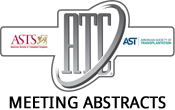2015 American Transplant Congress
Characteristics and Outcomes of Patients With Incidental Hepatocellular Carcinoma Detected in the Explanted Liver Following Transplant
Introduction: Despite pre-operative cross-sectional imaging, incidental hepatocellular carcinoma (iHCC) is sometimes diagnosed upon histological examination of the liver explant following transplantation for another indication. Whilst…2015 American Transplant Congress
Replacement of Lamivudine By Telbivudine to Improve Renal Function for Post-Transplant Hepatitis B Patients – A Randomized Clinical Trial
Background: Lamivudine is one of the anti-hepatitis B virus (HBV) agents to prevent HBV recurrence after transplantation because lamivudine is safe for long-term use. However,…2015 American Transplant Congress
Tandem P-Selectin Glycoprotein Ligand-Immunoglobulin (TSGL-Ig) Protects Liver Endothelial Cells Against Prolonged Cold Preservation Injury in Mouse Liver Transplantation
Background: Liver endothelial cell (LEC) damage is central in the pathogenesis of hepatic ischemia-reperfusion injury (IRI). LEC detachment/progressed denudation are typical during cold storage and…2015 American Transplant Congress
Adoptive Immunotherapy With Liver Allograft-Derived NK Cells Improves Recurrence-Free Survival After Living-Donor Liver Transplantation in Patients With Hepatocellular Carcinoma
Department of Gastroenterological and Transplant Surgery, Hiroshima University, Hiroshima, Japan.
Introduction: Previous studies revealed that the recurrence rate of hepatocellular carcinoma (HCC) was still 10–20%, even among liver transplantation (LT) recipients meeting the Milan criteria…2015 American Transplant Congress
Regional Variations: Liver Transplant Tourism Within the US
Aim: Given the current geographic disparities in average MELD scores at liver transplantation (OLT), there is increasing interest in patients who travel for OLT and…2015 American Transplant Congress
End of Treatment Liver Biopsy With Sofosbuvir: Histologic Changes Suggestive of Hepatitis C Activity in Liver Transplant Recipients With Achieved SVR
Background: Interferon (IFN) free HCV regimens are associated with better tolerability and efficacy. The majority of studies report biochemical and virological response; however limited information…2015 American Transplant Congress
Improved Renal Function Post-Liver Transplant With Earlier Everolimus Conversion
Calcineurin inhibitors (CNI) play an important role in preventing acute rejection (AR) post-liver transplant. Its long-term use is limited by development of nephrotoxicity. Optimal timing…2015 American Transplant Congress
Comparison of Renal Outcomes for Liver Transplant Recipients With Pretransplant Renal Dysfunction Receiving Sirolimus Or Tacrolimus With Rabbit Antithymocyte Globulin Induction
Published data are limited describing renal outcomes in orthotopic liver transplant (OLT) recipients prescribed de novo sirolimus (SRL) maintenance immunosuppression and rabbit antithymocyte globulin (rATG).…2015 American Transplant Congress
The Impact of CDC High Risk Donors on Patient and Graft Survival After Liver Transplantation
We hypothesized that CDC high risk donors (HRD) might be younger than non-HRD and have other characteristics associated with favorable outcomes after liver transplant (LT).…2015 American Transplant Congress
Single-Center Analysis of Adult, Combined Heart-Liver Transplant (CHLT) Recipients
Background: Combined heart-liver transplantation (CHLT) is life-saving for patients with end-stage heart-liver diseases. This is a review of patients who underwent CHLT at a single-center.Methods:…
- « Previous Page
- 1
- …
- 169
- 170
- 171
- 172
- 173
- …
- 180
- Next Page »
